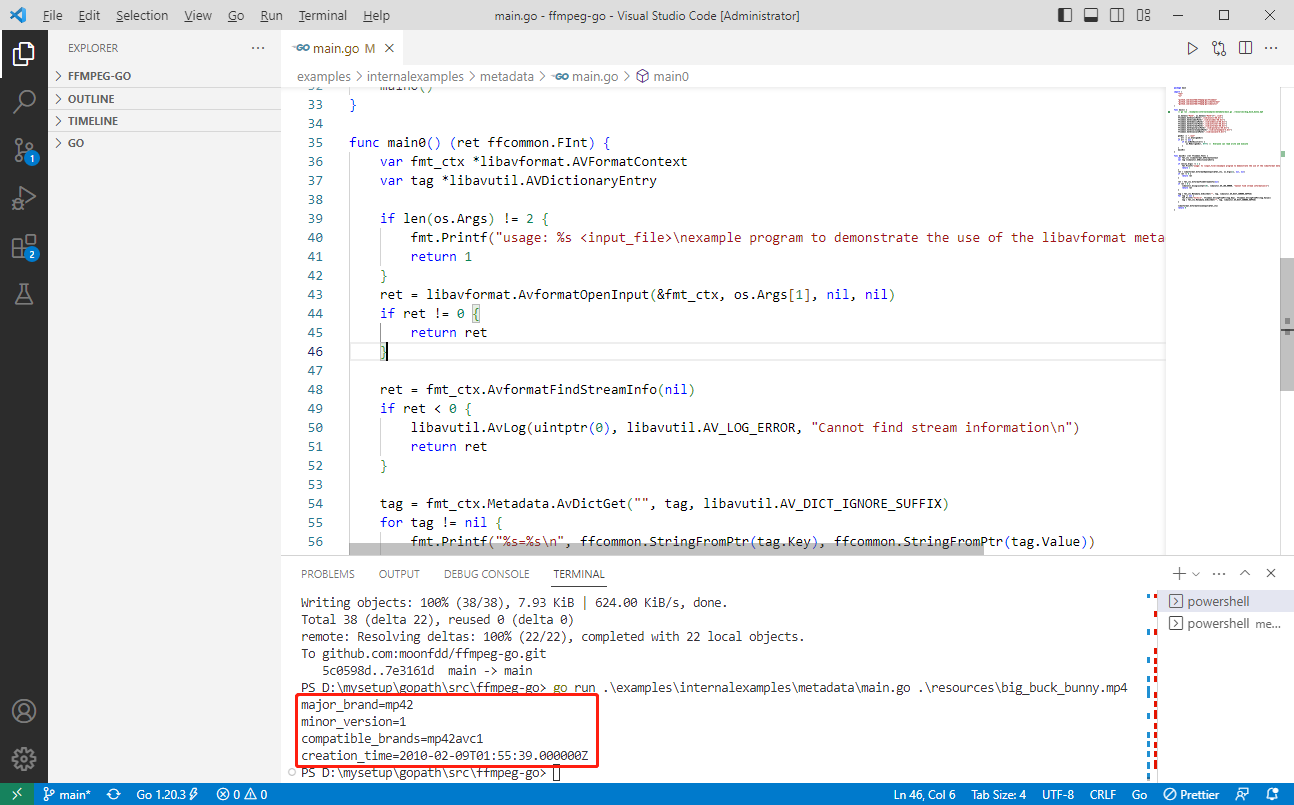2023-04-21:用go语言重写ffmpeg的metadata.c示例。
2023-04-21:用go语言重写ffmpeg的metadata.c示例。
答案2023-04-21:
这段 Go 代码演示了如何使用 ffmpeg-go 库中的函数来读取多媒体文件元数据,包括视频、音频等信息。它的大体过程如下:
- 设置环境变量以加载 FFmpeg 动态链接库
这里将 FFmpeg 库中的各个动态链接库路径添加到环境变量 PATH 中,以便在程序运行时能够自动加载。同时,通过 ffcommon 包中提供的函数设置各个库的路径。
- 创建一个输出目录
如果指定的输出目录不存在,则创建一个新的目录用于存储输出文件。
- 打开输入文件并查找流信息
使用 libavformat.AvformatOpenInput() 函数打开用户指定的输入文件,并将返回的 AVFormatContext 结构体指针赋值给 fmt_ctx 变量。然后调用 fmt_ctx.AvformatFindStreamInfo(nil) 函数查找输入文件中的流信息。
- 遍历元数据并输出
使用 fmt_ctx.Metadata.AvDictGet() 函数获取输入文件中的元数据。该函数返回指向 AVDictionaryEntry 结构体的指针,其中包含键值对形式的元数据信息。使用 for 循环遍历所有元数据,并使用 fmt.Printf() 函数输出每个元数据的键值对。
- 关闭输入文件
使用 libavformat.AvformatCloseInput(&fmt_ctx) 函数关闭输入文件并释放内存。
使用github/moonfdd/ffmpeg-go库。
命令如下:
go run ./examples/internalexamples/metadata/main.go ./resources/big_buck_bunny.mp4golang代码如下:
package main
import (
"fmt"
"os"
"github.com/moonfdd/ffmpeg-go/ffcommon"
"github.com/moonfdd/ffmpeg-go/libavformat"
"github.com/moonfdd/ffmpeg-go/libavutil"
)
func main() {
// go run ./examples/internalexamples/metadata/main.go ./resources/big_buck_bunny.mp4
os.Setenv("Path", os.Getenv("Path")+";./lib")
ffcommon.SetAvutilPath("./lib/avutil-56.dll")
ffcommon.SetAvcodecPath("./lib/avcodec-58.dll")
ffcommon.SetAvdevicePath("./lib/avdevice-58.dll")
ffcommon.SetAvfilterPath("./lib/avfilter-56.dll")
ffcommon.SetAvformatPath("./lib/avformat-58.dll")
ffcommon.SetAvpostprocPath("./lib/postproc-55.dll")
ffcommon.SetAvswresamplePath("./lib/swresample-3.dll")
ffcommon.SetAvswscalePath("./lib/swscale-5.dll")
genDir := "./out"
_, err := os.Stat(genDir)
if err != nil {
if os.IsNotExist(err) {
os.Mkdir(genDir, 0777) // Everyone can read write and execute
}
}
main0()
}
func main0() (ret ffcommon.FInt) {
var fmt_ctx *libavformat.AVFormatContext
var tag *libavutil.AVDictionaryEntry
if len(os.Args) != 2 {
fmt.Printf("usage: %s <input_file>\nexample program to demonstrate the use of the libavformat metadata API.\n\n", os.Args[0])
return 1
}
ret = libavformat.AvformatOpenInput(&fmt_ctx, os.Args[1], nil, nil)
if ret != 0 {
return ret
}
ret = fmt_ctx.AvformatFindStreamInfo(nil)
if ret < 0 {
libavutil.AvLog(uintptr(0), libavutil.AV_LOG_ERROR, "Cannot find stream information\n")
return ret
}
tag = fmt_ctx.Metadata.AvDictGet("", tag, libavutil.AV_DICT_IGNORE_SUFFIX)
for tag != nil {
fmt.Printf("%s=%s\n", ffcommon.StringFromPtr(tag.Key), ffcommon.StringFromPtr(tag.Value))
tag = fmt_ctx.Metadata.AvDictGet("", tag, libavutil.AV_DICT_IGNORE_SUFFIX)
}
libavformat.AvformatCloseInput(&fmt_ctx)
return 0
}

本作品采用《CC 协议》,转载必须注明作者和本文链接



 关于 LearnKu
关于 LearnKu




推荐文章: